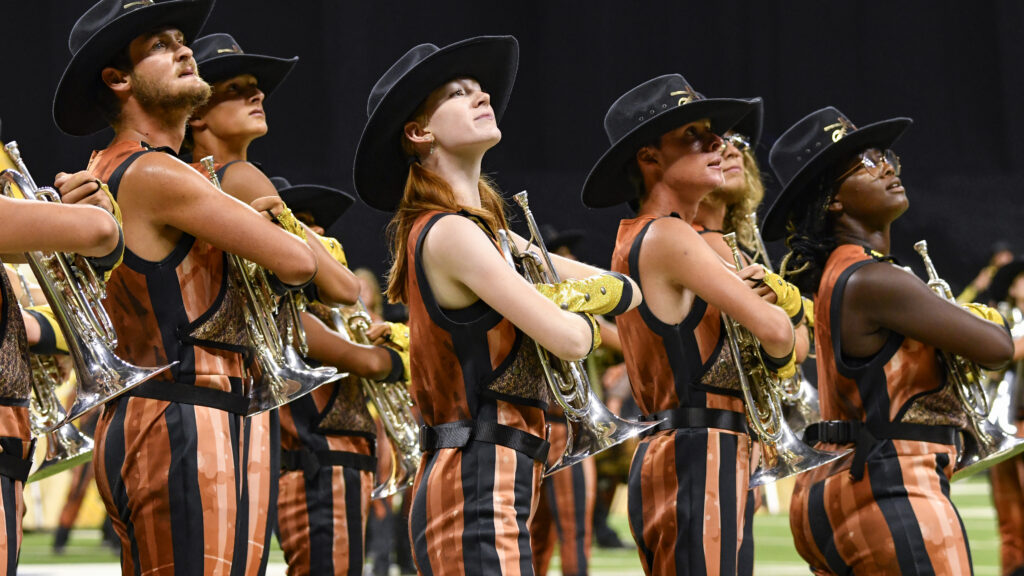The 1994 Drum Corps International World Championship was held at Foxboro Stadium outside Boston, predecessor to the much larger Gillette Stadium that greeted DCI 11 years later.
As the summer came to a close, the Blue Devils managed to cap off DCI’s first undefeated season since 1982. The closest anyone came to knocking off the corps’ “My Spanish Heart” production was the eventual fourth-place Cavaliers, who scored within a half a point of the Devils almost two weeks prior to the Finals in Foxboro.
The Cavaliers’ 1994 production, “Rituals,” explored the evolution of a person and culture, looking at the ceremonial experiences that identify important stages of growth and development. These experiences were primarily explored through characterizations in the guard, visualizations that often raised a few eyebrows for being so different from anything audiences had seen before.
A number of large ritual masks started the show amid the primitive sounds of “Sensemayá,” composed in 1937 by Mexican composer Silvestre Revueltas. The piece, written in the unusual meter of 7/4, was based on a Nicolás Guillén poem of the same title. In the poem, the Cuban poet conjured a pre-Columbian Afro-Caribbean chant about the male ritual held prior to the killing of a snake. Ethereal sounds akin to the rustling of wind through a rain forest were heard as clusters of men started to gather for the ritual.
Color guard members using ropes to represent the snakes wore smaller ritual facemasks, while those wielding sabers to kill the snakes wore no masks. Savage sounds and a menacing repeated rhythm pumped up the tension. Increased tribal savagery resulted in drill formations “attacking” one another, representing the males and the snakes trying to kill one another. After the snake was killed, the piece ended with all the color guard members working with flags as a tight block parallelogram uncoiled as if a snake releasing itself from life.
“Humming Chorus” from Sergei Prokofiev’s “Ivan the Terrible” was composed during 1942-1945 for a movie by Russian filmmaker Sergei Eisenstein that was set in the 16th Century. The melody appeared three times during the 13 movements of the film suite. The Cavaliers started the piece with a mellophone duet and utilized long wooden timbers upon which hung individual members of the guard. The solemnity of the work encouraged contemplation about what just happened and what was to come. Closing things out, a single guard member climbed the rungs of a vertical timber to stretch his right arm to the heavens, appearing to plead for salvation after the ravages of battle.
Ottorino Respighi originally wrote “Belkis, Queen of Sheba” in 1931 for a full-length ballet, one based on the biblical story of the queen and her visit to King Solomon. “War Dance,” depicting a ceremony in Solomon’s palace, was one of four movements of the suite extracted from the ballet. On the football field, the piece pitted parts of the corps against each other in anticipation of a coming battle. Primitive-sounding drumming accompanied the ritual brandishing of guard equipment as weapons. The selection ended with the rifle bearers victorious over the sabers, the sabers having fallen to the ground as if dead. The rifle bearers boldly thrust their weapons in the air while standing over their conquered foes.

The horn line sang in harmony for the start of Respighi’s “St. Michael the Archangel,” the second movement from his 1926 suite, “Church Windows.” In the Holy Bible, St. Michael is the angel that leads the army of God against the forces of evil. The Cavaliers ended the piece in somber mourning for those who lost their lives in the prior battle and passed on to the spirit world. One of the vanquished guard members was carried to the front and laid on the field by seven of his brethren, with a mellophone soloist walking over to pay tribute to the fallen soldier. A large squiggly arc spreading goal line to goal line separated the earthly domain from the afterlife, the heavenly domain represented with billowing white flags.
As the brass section gathered toward the front of the field, sounds of “Sensemayá” were once again heard and images of prior motifs, including the snakes, made a curtain call as the closer was introduced. Paul Hindemith’s “March” from “Symphonic Metamorphosis” is the last of the four movements from the 1943 suite written by the composer after he moved to America to escape Nazi Germany. Early 19th Century German composer Carl Maria von Weber wrote the piano works upon which Hindemith based his musical tribute.
The Cavaliers concluded the show with a proclamation of glory, including a rousing and boisterous statement of Hindemith’s triumphant French horn melody, heard in the mellophones. The famed melody accompanied a drill formation depicting a battle shield of victory. At the end, the various visual props employed throughout the show were brought back out for one last viewing, held aloft by the guard members in celebration of reigning triumphant over tremendous odds.
1994 Overview

Michael Boo was a member of the Cavaliers from 1975-1977. He wrote about the drum corps activity for more than 35 years while serving as a staff writer for various Drum Corps International projects. During his lifetime Boo wrote for numerous other publications including an honors-winning book on the history of figure skating. He also was an accomplished composer. Boo passed away in 2020 and was inducted into the DCI Hall of Fame posthumously in 2021.





